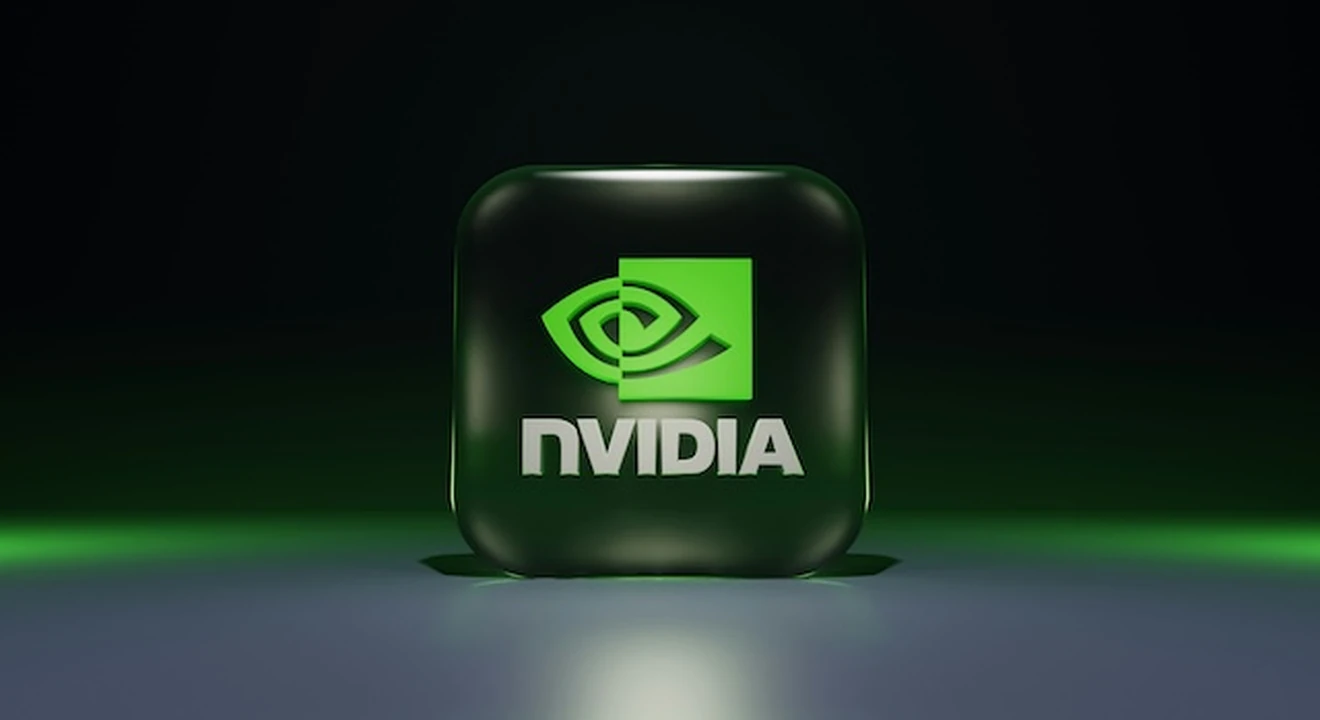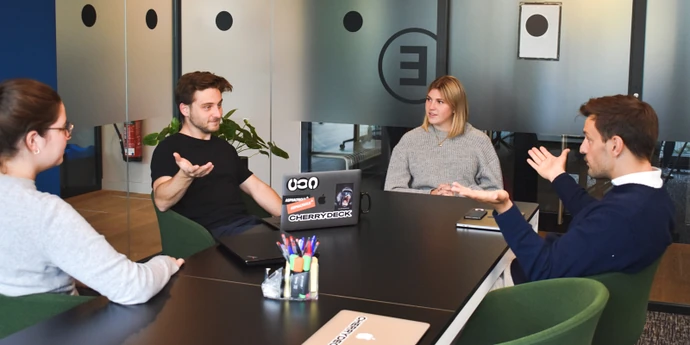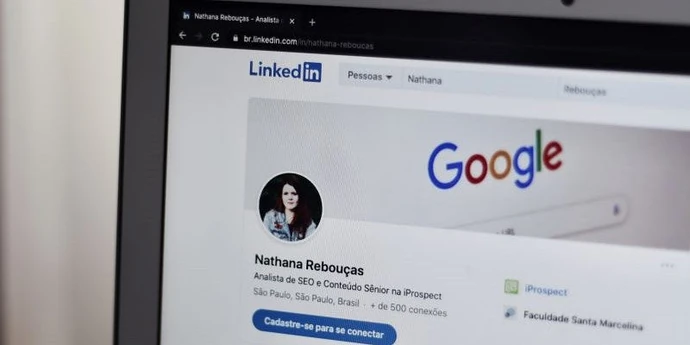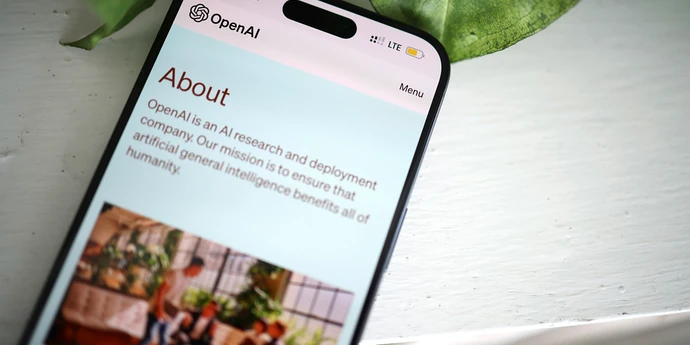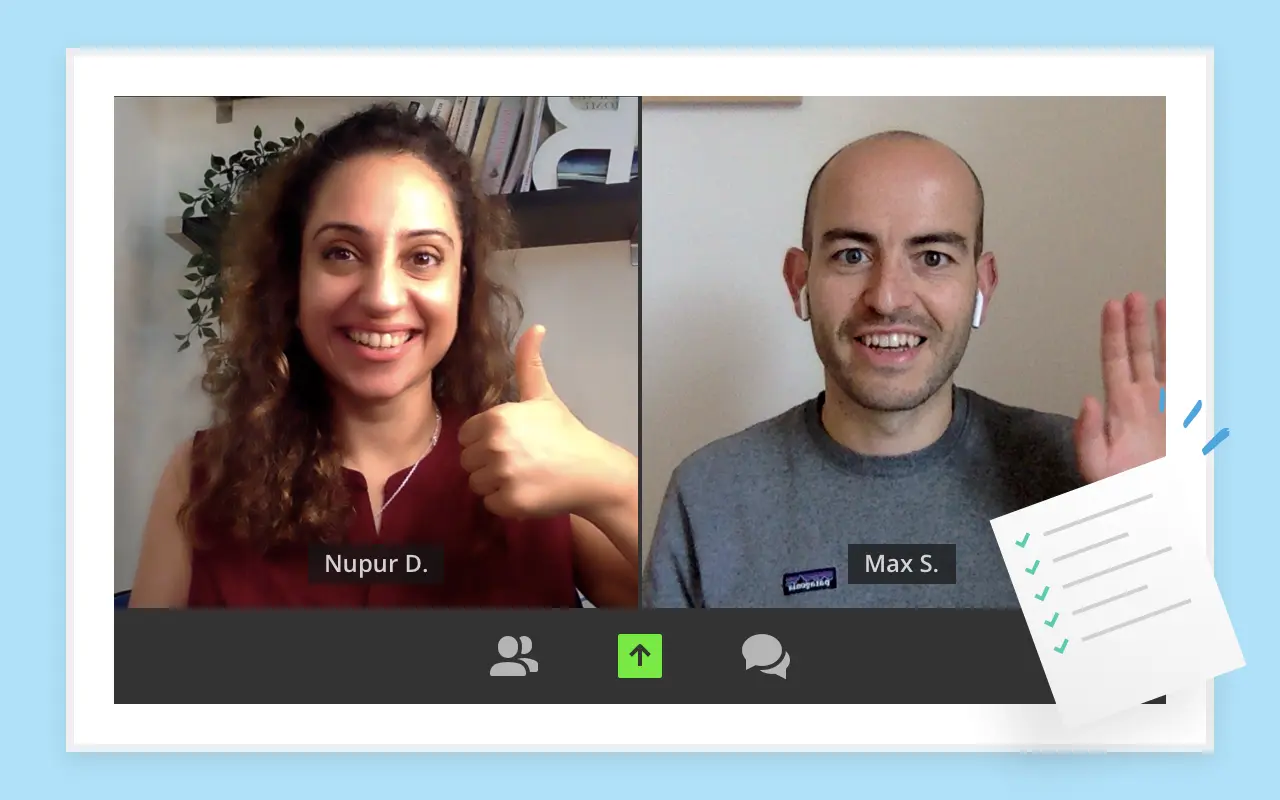In this guide, we cover everything you need to know to prepare for software engineer interviews at NVIDIA.
To put together this guide, we gathered insights from hundreds of real NVIDIA candidates on Glassdoor, plus other reliable resources like Levels.fyi and the NVIDIA website.
Below, you’ll learn about NVIDIA’s interview process, see example NVIDIA interview questions, and understand how to answer them.
Here's an overview of what we'll cover:
- Role and salary
- Interview process and timeline
- Example NVIDIA software engineer interview questions
- Interviewing tips
- Preparation plan
Let’s dive in!
Click here to practice 1-on-1 with an ex-NVIDIA Software Engineer (SWE) interviewer
1. Role and salary ↑
Before we dive into the interview process and questions, let’s quickly cover some basics about the role you’re applying for.
1.1 What does an NVIDIA software engineer do?
NVIDIA software engineers play a pivotal role in developing the software that powers the company's advanced hardware and computing platforms. Their responsibilities span a wide range of areas, including:
- System software development
- Hardware-software integration
- Performance optimization
In addition to system-level work, collaboration is crucial to NVIDIA’s successes in technological innovation.
NVIDIA software engineers collaborate closely with hardware teams to create the company’s products. They are involved in designing, developing, and verifying features for next-generation System-on-Chip (SoC) architectures, participating in early modeling simulations, and working with hardware, silicon, and pre-silicon teams on new platforms.
Lastly, NVIDIA software engineers build tools that help outside developers employ their powerful GPUs more effectively. This spreads the use of NVIDIA’s technology across different industries like science, medicine, and creative software.
1.2 NVIDIA software engineer salary and compensation
NVIDIA’s generous compensation package is probably one of the reasons you’re interested in working at the company. Here are the average salaries and compensations for the different software engineer levels at NVIDIA. This is based on the reported data from Levels.fyi.

NVIDIA software engineers make 82.8% higher in average total salary compared to other software engineers in the US, according to Levels.fyi data.
Compensation mainly depends on two key factors: location and level.
- Location: For example, NVIDIA software engineers in the US make significantly higher at every level than their counterparts in India. This is largely influenced by local market norms, such as cost of living, market wages, and taxes.
- Level: The base salary and total compensation go up with each SWE level. NVIDIA’s entry-level position pays 31.8% higher than similar roles at companies like AMD, which is their biggest rival in the GPU market. However, they are surpassed by top FAANG companies like Google, Meta, and Amazon.
While we presume that you already know which specific SWE level you are applying for, it’s still good practice to double-check this with your recruiter. Your recruiter should be able to advise you on which level you’re being evaluated.
And keep in mind, compensation packages are always negotiable, even at NVIDIA. If you do get an offer, don’t be afraid to ask for more!
Use this guide to the best salary negotiation services to help you prepare.
2. Interview process and timeline ↑
2.1 What steps should you expect?
What's the NVIDIA software engineering interview process and timeline? NVIDIA’s interview process takes around 6-8 weeks and typically follows these steps:
- Recruiter call
- Technical screen
- Hiring manager call
- Onsite interviews (3-6 rounds)
- Offer and final negotiations
Note that the exact process can vary slightly depending on the exact role and team you’re applying for.
2.1.1 Resume screening
NVIDIA recruiters focus on relevant background and technical skills. The company recommends that you make sure your resume aligns with the role you’re applying for, so take extra care to tailor your application (use our software engineer resume guide and examples).
If you’re looking for expert feedback, get input from our team of ex-FAANG recruiters, who will cover what achievements to focus on (or ignore), how to fine-tune your bullet points, and more.
2.1.2 Recruiter call (30 minutes, may be skipped for referred candidates)
If your resume passes the initial screening, a recruiter may contact you for a brief 30-minute call to discuss:
- Your general background and experience
- Your interest in NVIDIA and the specific role
- Basic skills assessment
This stage is also your chance to ask questions about the role you’re applying for and what to expect if you make it through to the next stage.
If you’re a referred candidate, they may choose to skip this step.
2.1.3 Technical screen (30-60 minutes)
This stage is the first technical assessment. Their purpose here is to evaluate your basic competencies in problem-solving and coding, as well as further discussions on your past experiences.
Here’s what to expect during the technical phone screen:
- Coding challenges focused on CS fundamentals, like data structures and algorithms
- Domain-specific questions on topics like LLM or GPU programming
- Behavioral questions about your past technical projects
The coding challenges are usually done on HackerRank on a whiteboard or laptop provided by the company. You will not be allowed unapproved outside tools, including ChatGPT, and breaking these rules will of course result in the disqualification of your candidacy.
2.1.4 Hiring manager call (30 minutes)
If you pass the initial technical phone screen, a hiring manager may contact you to further assess your behavioral skills. If you do receive this call, you can expect to discuss two things: cultural fit and role/team details.
- Cultural fit: The hiring manager will further probe into your work experience and how it aligns with the team’s needs. They’ll also assess your communication style and workplace values.
- Role/team details: This is the part where the hiring manager tries to sell you on the specific position you’re applying for. They’ll provide an overview of the team’s projects and expectations.
2.1.5 Onsite interviews (5 hours, 3-6 rounds)
The final stage is the onsite interviews of 3-6 rounds, which assess your deeper technical knowledge. At this stage, interviewers are looking at your ability to write production-grade code, your optimization skills, and how you think under pressure.
The interviews may be a mix of one-on-one assessments and panel-style discussions. Here are the different types of interviews you may need to complete:
- Coding interviews: Advanced problem-solving exercises in languages like C++ or Python.
- System design interview: Questions that evaluate your ability to design scalable systems, discuss architecture, and evaluate trade-offs.
- Domain-specific interview: Questions tailored to the specific role you’re interviewing for. This can include questions related to CUDA programming and machine learning.
These onsite interviews are the most in-depth stage of NVIDIA’s software engineer interview process. Many candidates on Glassdoor report having to do multiple rounds for some interview types, so you’ll want to make sure you’re thoroughly prepared.
2.1.6 Offer and final negotiations
After completing the onsite interviews, candidates who receive an offer may undergo final discussions with managerial staff and team matching. You’ll also have the chance to negotiate your salary before finalizing your employment terms.
And finally, you also get the option to speak with a Community Resource Group member as part of NVIDIA’s Insider Chat program! This 15-minute chat is optional and doesn’t influence hiring decisions. It’s simply an opportunity to learn more about NVIDIA’s company culture before you accept your offer.
2.2 Differences between NVIDIA software engineer levels and roles
NVIDIA structures its software engineering roles into a series of Individual Contributor (IC) levels. Each level reflects an increase in expertise, responsibility, and compensation.
Understanding these levels can help you set your career goals and expectations as a software engineer.
Here's an industry overview of what’s typically required at each level:

3. Example NVIDIA software engineer interview questions ↑
Let’s take a closer look at the 4 types of interviews you may encounter as an NVIDIA software engineer candidate: coding interviews, domain-specific interviews, system design interviews, and behavioral interviews.
We’ve analyzed hundreds of questions reported by former NVIDIA software engineer candidates on Glassdoor. Below, see curated lists of sample questions for each interview type.
3.1 Coding interview questions
NVIDIA software engineers solve some of the company's most difficult problems with code. It's therefore essential that you have strong problem-solving skills.
You'll face up to 3 coding interviews at NVIDIA. You'll need to show that you think in a structured way and write code that's accurate, bug-free, and fast.
Judging by candidate reports on Glassdoor, the typical difficulty level is LeedCode medium, although this may increase if you're interviewing at a higher level.
You can also expect “trivia”-like questions that test your knowledge about an area of coding, rather than asking you to solve a problem. These are most common in the early rounds, as the recruiter or hiring manager tries to get a sense of your level of expertise.
Here are the most common question types asked in NVIDIA software engineer coding interviews:
- Graphs / Trees
- Arrays / Strings
- Linked Lists
- Search / Sort
- Stacks / Queues
- Geometry / Maths
- Recursion
- Dynamic Programming
- Concurrency
Below, we've listed common examples used at NVIDIA for each question type.
Example coding interview questions asked at NVIDIA
- Write a BFS for a generic graph.
- Write a BFS on a "sorted" binary tree, which prints nodes values in level order.
- Topologically sort a Directed Acyclic Graph (DAG) and detect cycles.
- Write a function to print the left view of a Binary Search Tree.
- Write a program to print the height of a given Binary Tree T.
- Write a program to determine if a given Binary Tree is a Binary Search Tree or not, given the root of the Binary Tree.
- You’re given two Binary Trees, T and S. Write a code to determine if the Binary Tree S is a Subtree of the Binary Tree T.
- Write a program to convert a given Binary Tree into a Special Max Heap.
- Given an nxn grid of 1s and 0s, return the number of islands in the input.
- Write as many functions as possible that take an 'X' or 'Y' as input and return the opposite.
- Find in the array two elements whose sum is equal to a given constant.
- Given an array, find the largest subarray containing all consecutive elements.
- String concat in C language.
- Write a program to find and print the duplicate elements in a given array.
- Write a function to check whether a string contains a substring.
- Given an integer array nums and an integer k, return true if nums has a subarray of at least two elements whose sum is a multiple of k.
- Create a linked list struct with some of the operations in C language.
- Design and implement an LRU cache with a maximum size and basic get+set operations.
- Given the head of a linked list, determine if the linked list has a cycle in it. There is a cycle in a linked list if there is some node in the list that can be reached again by continuously following the next pointer. Internally, pos is used to denote the index of the node that the tail's next pointer is connected to. Note that pos is not passed as a parameter. Return true if there is a cycle in the linked list. Otherwise, return false.
- Reverse a linked list.
- Given the head of two singly linked lists, write a function to return the point where they intersect (if any).
- Sort an array (given) in o(n) runtime.
- Find in the array 2 elements whose sum is equal to a given constant.
- Given a sorted array that has been rotated by k elements, provide an O(log n) solution to find a specific element.
- Given a 2D array, assume that we are reading its elements in row order and column order; which would be better/faster?
- Merge intervals.
- Define a stack with normal operations such as push, pop, top, and a new operation max which always returns the max element in the stack.
- Design a stack class with an additional operation findMin to return the minimum element at any given time.
- Implement stack using an array.
- Implement LRU Cache.
- Implement matrix multiplication in C++.
- Write a program to transpose a given Matrix M.
- Write a function that pads the width to the nearest multiple of N.
- Implement a convolution kernel. Include padding and write the exact code.
- Write pseudocode to determine whether or not a number is in the correct position on a sudoku board.
- What do you do first to make a modification to the actual code?
- Write a function to print 1 to n without using a loop.
- For a given array containing positive integers, write a program to find the longest increasing subsequence.
- Design an algorithm to ensure a high-priority process gets a lock as soon as it wants, considering non-preemptive and preemptive processes.
Finally, we recommend reading our guides on how to prepare for a coding interview, how to answer coding interview questions, and practicing with this list of coding interview examples.
3.2 Domain-specific interview questions
NVIDIA is known for building cutting-edge hardware and software that power everything from autonomous vehicles to AI supercomputers.
To assess whether candidates are equipped for this kind of work, NVIDIA often includes domain-specific questions focused on two things:
CUDA programming matters because CUDA is NVIDIA’s core product. It’s the programming model that unlocks the power of their GPUs, especially for graphics rendering and real-time applications, which are essential aspects of their business. As a software engineer, you’ll be expected to understand and optimize it.
Interviewers will also assess your understanding of how computers manage memory and run multiple tasks at once. These are important concepts when working on complex systems like GPUs.
As for operating systems, this subject is important because interviewers will assess your understanding of how software and hardware interact at a low level. It is a huge part of what NVIDIA software engineers do.
Here are some common domain-specific questions you can expect:
Example domain-specific interview questions asked at NVIDIA
- Explain the concept of memory coalescing in CUDA and why it's important for performance.
- What are some strategies to optimize memory usage in CUDA applications?
- How do you profile a CUDA application to identify performance bottlenecks?
- How do you ensure that a CUDA kernel is scalable across different GPU architectures?
- What are some methods to optimize data transfer between the host and device in CUDA?
- What are some common pitfalls in CUDA programming and how can they be avoided?
- What are some best practices for writing maintainable and efficient CUDA code?
- What is the difference between kernel mode and user mode?
- What is the use of stack and queue in OS?
- What is stack overflow?
- Can you explain virtual memory to us?
- Describe shared memory in relation to the Linux Kernel.
- Define memory hierarchy in an OS.
- What aspects of User Graphics would you consider while developing a desktop game application?
To learn more about CUDA programming, check out NVIDIA’s comprehensive learning resources:
3.3 System design interview questions
System design interviews typically begin with a broad prompt, like "Design a platform like Facebook.” Then, you'll be expected to generate a high-level design that shows the different system components that will be required, how they're connected, and any trade-offs in the approach you've taken.
The frequency of these interviews will depend on what role you’re applying for. As a rule of thumb, the more senior the position, the more system design interviews you’ll have.
Here are some common system design questions asked in Nvidia software engineer interviews:
Example system design interview questions asked at NVIDIA
- How would you design a chatbot service that provides users with a variety of information?
- How would you perform API modeling while managing multiple servers?
- Create a memory management system that allocates fixed-size blocks, in a constrained environment with limited memory. Avoid using malloc, free, new, or delete; instead, rely on a 'memory' function for both managing memory and allocating space for clients.
- How would you design a memory allocator?
- How would you design an interface for managing and running jobs on various GPUs?
- Here is our system (description provided). How would you design it?
- How would you design a platform like Facebook or Uber?
- How would you design a proximity server?
- How would you design a shared file system that stores files in the cloud?
For more information, read our system design interview questions and prep guide.
3.4 Behavioral and fit interview questions
NVIDIA looks for well-rounded software engineers who are proactive and able to collaborate within their teams, as well as cross-functionally. The company will also assess how well you align with NVIDIA’s core values of innovation, speed and agility, excellence, intellectual honesty, and togetherness.
Example behavioral and fit interview questions asked at NVIDIA
- Tell me about yourself and your background.
- Tell me about a recent project you worked on.
- Why do you want to work at NVIDIA? Why did you apply to this role?
- What are your strengths and weaknesses?
- How do you prioritize tasks?
- Tell me about the most challenging project you've worked on.
- Tell me about a time you had to make a big decision for a crucial client project.
- Can you describe a challenging technical problem you faced during a software development project, how you approached it, and what steps you took to overcome it?
- Tell me about a time when you disagreed with your superiors.
- Tell me about a time you had a conflict with someone. How did you resolve it and what did you learn?
- Tell me about a time you received negative feedback and how you handled it.
For more guidance, read our guide to the most common software engineer behavioral interview questions.
4. Interviewing tips ↑
You might be a fantastic software engineer, but unfortunately, that won’t necessarily be enough to ace your interviews at NVIDIA. Interviewing is a skill in itself that you need to learn.
Let’s look at some key tips to make sure you approach your interviews the right way.
1. Ask clarifying questions.
Often the questions you’ll be asked will be quite ambiguous, so make sure you ask questions that can help you clarify and understand the problem. Most of the questions will focus on testing your technical proficiency.
2. Be conversational.
NVIDIA wants to know if you have excellent communication skills. So make sure you approach the interview like a conversation.
3. Think out loud.
You need to walk your interviewer through your thought process before you actually start coding or designing a system. This helps them understand your logic and shows your critical thinking.
4. State and check assumptions.
You need to explicitly state assumptions and check with your interviewer to see if those assumptions are reasonable.
5. Present multiple possible solutions.
Before you code, present multiple possible solutions if you can. NVIDIA interviewers want to know your reasoning for choosing certain solutions.
6. Be honest and authentic.
Be genuine in your responses. NVIDIA interviewers appreciate authenticity and honesty. If you faced challenges or setbacks, discuss how you improved and learned from them.
7. Center on NVIDIA’s values.
Familiarize yourself with NVIDIA’s core values and align your behavioral responses with them. NVIDIA values certain attributes such as intellectual honesty, excellence, speed, and agility.
8. Brute force, then iterate.
When coding, don’t necessarily go for the perfect solution straight away. First try and find a solution that works, then iterate to refine your answer.
9. Keep your code organized.
Make sure to keep your code organized, so your interviewer won’t have difficulty understanding what you’ve written. The interviewer will want to see that your code has captured the right logical structure.
10. Get comfortable with coding in various mediums.
NVIDIA typically asks candidates to code on platforms like HackerRank if the interview is done online. But if the interview is in person, you may be asked to code on paper or a whiteboard. You can check with your recruiter if you’re unsure which medium to use.
5. Preparation plan ↑
Now that you know what questions to expect, let's focus on how to prepare.
It's no secret that the performance bar at NVIDIA is high. Some people even go as far as quitting their jobs to prepare for interviews full-time. This is extreme and not what we recommend doing, but it shows how much effort some candidates are ready to put in.
Below, we’ve listed free resources and the four steps recommended to prepare as efficiently as possible.
5.1 Deep dive into NVIDIA’s company culture and products
Most candidates fail to do this. But before investing tens of hours preparing for an interview at NVIDIA, you should take some time to make sure it's actually the right company for you.
NVIDIA is prestigious and it's therefore tempting to ignore that step completely. But in our experience, the prestige in itself won't make you happy day-to-day. It's the type of work and the people you work with that will.
If you know engineers who are current or former NVIDIA employees, it's a good idea to talk to them to understand what the culture is like. In addition, we would recommend reading about NVIDIA as an organization itself and its company products.
Here are some free resources by NVIDIA to help you get started:
- Life, culture, and career at NVIDIA
- NVIDIA blog
- NVIDIA annual reports and proxies
- NVIDIA employee content and testimonials
- NVIDIA’s innovation strategy
5.2 Practice by yourself
As mentioned above, you'll have multiple types of interviews at NVIDIA: coding, domain-specific, system design, and behavioral. The first step of your preparation should be to brush up on these different types of questions and to practice answering them by yourself.
For coding interviews, we recommend using our coding interview prep article as your one-stop shop to guide you through your preparation process.
For system design interviews, we recommend studying our guide on how to answer system design interview questions, which covers a step-by-step answer framework (equally relevant for product design).
For behavioral interviews, we recommend learning our step-by-step method of answering behavioral questions and then practicing the most common software engineer behavioral interview questions.
Finally, a great way to practice is to interview yourself out loud. This may sound strange, but it will significantly improve the way you communicate your answers during an interview. Play the role of both the candidate and the interviewer, where you ask yourself the questions and answer them as you would in an interview.
However, you can’t simulate thinking on your feet or the pressure of performing in front of a stranger by yourself. Plus, there are no unexpected follow-up questions and no feedback.
That’s why many candidates try to practice with friends or peers.
5.3 Practice with peers
If you have friends or peers who can do mock interviews with you, that's an option worth trying. It’s free, but be warned, you may come up against the following problems:
- It’s hard to know if the feedback you get is accurate.
- They’re unlikely to have insider knowledge of interviews at your target company.
- On peer platforms, people often waste your time by not showing up.
For those reasons, many candidates skip peer mock interviews and go straight to mock interviews with an expert.
5.4 Practice with experienced ex-NVIDIA software engineer interviewers
In our experience, practicing real interviews with experts who can give you company-specific feedback makes a huge difference.
Find an NVIDIA software engineer interview coach so you can:
- Test yourself under real interview conditions
- Get accurate feedback from a real expert
- Build your confidence
- Get company-specific insights
- Learn how to tell the right stories, better
- Save time by keeping your preparation focused
Landing a job at a big tech company often results in a $50,000 per year or more increase in total compensation. In our experience, three or four coaching sessions worth ~$500 make a significant difference in your ability to land the job. That’s an ROI of 100x!
Click here to book software engineer mock interviews with experienced SWE interviewers.






